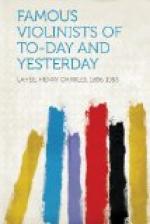During this tour, she made the acquaintance of Johannes Brahms, who took a great deal of interest in her, advised her to devote all her energies to the violin, and succeeded in arranging for another interview with Joachim, the result of which was that she was enabled to enter the Berlin High School for Music. Here she pursued her studies until 1882, after which she still continued her studies and took private lessons of Joachim.
At the high school she gained the Mendelssohn prize, and from that time commenced her career as a virtuosa, touring extensively throughout Europe. One of her greatest triumphs was when, in 1885, at Vienna, she played Brahm’s violin concerto with Richter’s orchestra.
Her career has been marked by hard work and continual practice, which have enabled her to overcome many obstacles, and have placed her on a level with the very best violinists of her sex.
The Ladies’ String Quartet, which she formed in Berlin, consisting of herself as first violin, with Agnes Tschetchulin, Gabrielle Roy, and Lucie Campbell, had a creditable career, and appeared in several German cities.
In 1889 Marie Soldat married a lawyer named Roeger, but did not retire from her profession. She is now known as Madame Soldat-Roeger.
Gabrielle Wietrowitz was born a few years later, in 1866, at Laibach, and was also a pupil at the Musical Institute at Gratz. Her father was a military bandsman who had some knowledge of the violin, which enabled him to give his daughter elementary instruction on that instrument.
After a few years he left Laibach to settle in Gratz, and Gabrielle took violin lessons from A. Geyer (some accounts say Caspar). On entering the Musical Union she made a sensation by playing brilliantly at a concert before a large audience. She was then eleven years of age, and from that time she made the most rapid progress, taking first prize at the annual trial concert. In consequence of her great promise Count Aichelburg, who was a member of the Directorate of the Musical Union, presented her with a valuable violin, and the Directorate assigned her a yearly salary which enabled her to go to Berlin and enter the high school, where she became a pupil of Joachim in 1882.
At the high school her career was as brilliant as it had been in Gratz, for at the end of her first year she succeeded in capturing the Mendelssohn prize, which brought her 1,500 marks, and at the end of her third year she took it for a second time.
She remained at the high school three years, after which she began a splendid career by playing the concerto by Brahms at the St. Cecilia Festival at Muenster. Then followed a series of concert tours, which resulted in securing her a reputation as one of the most brilliant stars amongst women.
Miss Wietrowitz plays with the most consummate ease the greatest works of the modern school. She has a powerful and brilliant tone, with sweet tenderness and sympathy, which appeal to the soul of the listener, and she confines her repertoire to the highest class of musical compositions. She has recently succeeded Miss Emily Shinner as first violin in the quartet which that talented lady established in England.




